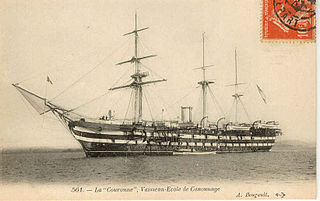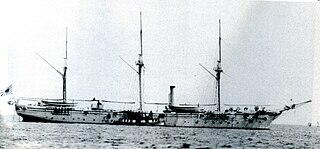
A ship of the line was a type of naval warship constructed during the Age of Sail from the 17th century to the mid-19th century. The ship of the line was designed for the naval tactic known as the line of battle, which involved the two columns of opposing warships manoeuvering to volley fire with the cannons along their broadsides. In conflicts where opposing ships were both able to fire from their broadsides, the faction with more cannons firing – and therefore more firepower – typically had an advantage.

USS Pennsylvania was a three-decked ship of the line of the United States Navy, rated at 130 guns, and named for the state of Pennsylvania. She was the largest United States sailing warship ever built, the equivalent of a first-rate of the British Royal Navy. Authorized in 1816 and launched in 1837, her only cruise was a single trip from Delaware Bay through Chesapeake Bay to the Norfolk Navy Yard. The ship became a receiving ship, and during the American Civil War was destroyed.

An ironclad was a steam-propelled warship protected by steel or iron armor constructed from 1859 to the early 1890s. The ironclad was developed as a result of the vulnerability of wooden warships to explosive or incendiary shells. The first ironclad battleship, Gloire, was launched by the French Navy in November 1859, narrowly preempting the British Royal Navy. However, Britain built the first completely iron-hulled warships.

During the 18th and 19th centuries, a sloop-of-war was a warship of the British Royal Navy with a single gun deck that carried up to 18 guns. The rating system of the Royal Navy covered all vessels with 20 or more guns; thus, the term encompassed all unrated warships, including gun-brigs and cutters. In technical terms, even the more specialised bomb vessels and fire ships were classed by the Royal Navy as sloops-of-war, and in practice these were employed in the role of a sloop-of-war when not carrying out their specialised functions.

Steam frigates and the smaller steam corvettes, steam sloops, steam gunboats and steam schooners, were steam-powered warships that were not meant to stand in the line of battle. The first such ships were paddle steamers. Later on the invention of screw propulsion enabled construction of screw-powered versions of the traditional frigates, corvettes, sloops and gunboats.

USS Merrimack, also improperly Merrimac, was a steam frigate, best known as the hull upon which the ironclad warship CSS Virginia was constructed during the American Civil War. The CSS Virginia then took part in the Battle of Hampton Roads in the first engagement between ironclad warships.

Jylland is a Danish frigate, and is both a screw-propelled steam frigate and a sailship. It took part in the Battle of Heligoland on 9 May 1864, and is preserved as a museum ship in the small town of Ebeltoft, located on the Djursland peninsula in Denmark.

USS Contoocook was a screw sloop-of-war built for the United States Navy during the American Civil War. She is named after a river and village in New Hampshire. She was launched 3 December 1864 at Portsmouth Navy Yard and commissioned 14 March 1868, commanded by Captain George Balch.

HMS Research was a small ironclad warship, converted from a wooden-hulled sloop and intended as an experimental platform in which to try out new concepts in armament and in armour. She was launched in 1863, laid up in 1878 and sold for breaking in 1884, having displayed serious limitations as a warship.

HMS Algerine was a Phoenix-class steel screw sloop of the Royal Navy. She was launched at Devonport in 1895, saw action in China during the Boxer Rebellion, and later served on the Pacific Station. She was stripped of her crew at Esquimalt in 1914, and transferred to the Royal Canadian Navy in 1917, being commissioned as HMCS Algerine. She was sold as a salvage vessel in 1919 and wrecked in 1923.

The French ironclad Couronne ("Crown") was the first iron-hulled ironclad warship built for the French Navy in 1859–1862. She was the first such ship to be laid down, although the British armoured frigate HMS Warrior was completed first. The ship participated in the Franco-Prussian War of 1870–1871, but saw no combat. She was served as a gunnery training ship from 1885 to 1908 before she was hulked the following year and became a barracks ship in Toulon. Couronne was scrapped in 1934, over 70 years after she was completed.

Amagi was a screw sloop in the early Imperial Japanese Navy, and was the third vessel built by the Yokosuka Naval Arsenal after its acquisition by the Meiji government. When built, Amagi was the largest warship yet produced domestically in Japan. Amagi was named after the Mount Amagi, in Shizuoka Prefecture, Japan.
USS Wanaloset, also spelled USS Wanalosett, was a proposed United States Navy screw sloop-of-war or steam frigate that appears never to have been laid down.
USS Watauga was a proposed United States Navy screw frigate that was never built.
USS Arapahoe was a proposed United States Navy screw sloop-of-war or steam frigate that was cancelled in 1866 without being completed.
USS Keosauqua was a proposed United States Navy screw sloop-of-war or steam frigate that was cancelled in 1866 without being completed.

The Ister-class frigates were a group of five 36-gun screw frigates ordered for the Royal Navy in the early 1860s. Four of the ships were cancelled after they were laid down and HMS Endymion was the only ship completed.

SMS Custoza was an ironclad warship built for the Austro-Hungarian Navy in the 1870s, the only member of her class. She was the first Austro-Hungarian ironclad to be built after the navy studied the results of the Battle of Lissa of 1866; she was also the first iron-hulled capital ship to be built for the Austro-Hungarian Navy. She was laid down in November 1869, launched in August 1872, and completed in February 1875. Her career was fairly limited, in part due to reduced naval budgets in the 1870s that also delayed her completion. Custoza was somewhat more active in the 1880s, taking part in an international naval demonstration against the Ottoman Empire in 1880, being modernized in 1882, and a trip to Spain for the Barcelona Universal Exposition in 1888. The ship became a training ship in 1902, was converted into a barracks ship in 1914, and after World War I, was awarded as a war prize to Italy. Custoza was immediately broken up.

San Giovanni was a sail corvette built for the Royal Sardinian Navy in the late 1840s. In 1861, she was converted into a screw corvette by which time the unification of Italy had been largely completed. As a result, she served with the Italian Regia Marina when the work on the ship was finished. She was present for the Battle of Lissa in 1866 during the Third Italian War of Independence, though she did not engage the Austrian Navy in the battle. She was eventually laid up in 1875 and broken up for scrap in 1878.














